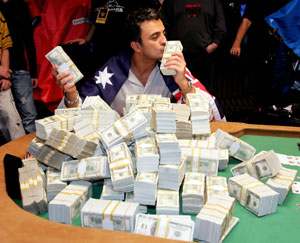Bluffing

Bluffing is one of the most famous of all poker concepts. A bluff is a bet or raise
when you have little chance of winning the pot if you are called. For example, you
hold 6
♦ 5
♦ with a Q
♦ T
♦
8
♥ A ♣ board. A 2
♥ falls on the river and you bet. This is a
bluff, as you have no chance of winning the pot if someone calls. A semi-bluff is a
bet or raise in which, if called, you probably do not have the best hand, but you
could improve to the best hand. Let's look first at pure bluffs.
Bluffing is profitable when your pot odds are better than the odds that your
opponents will fold. For example, if you feel there is a 20% chance that your
opponents will fold, then a $2 bet is profitable if the pot is greater than $8. The key
to bluffing successfully is your ability in determining the probability that your
opponents will fold.
Let's discuss several factors when considering a bluff:
- Number of opponents: Bluffs are generally only successful against one or
two opponents and sometimes against three. Bluffs are rarely successful
against four or more opponents.
-
Type of opponent: It is easier to bluff against strong players than maniacs or
weak players. Strong players are capable of folding mediocre hands.
Maniacs and poor players call too often with weak hands, so it is more
difficult to get them to fold.
-
Size of pot: The larger the pot, the harder it is to bluff successfully. Your
opponents are getting better pot odds, so they are more likely to cull even
with weak hands. On the other hand, you get a larger reward when you are
able to bluff successfully at a large pot.
-
Table image: Loose players play a lot of hands and tend to bluff a lot, while
tight players play few hands and generally only bet when they have a strong
hand. Bluffs have a higher chance of success when you have a tight table
image since your opponents will tend to back off when you bet. If you have a
loose table image, more opponents will tend to call you with weak hands. If
you recently were "caught" trying to bluff, this may also make it more difficult
to bluff successfully.
- Betting sequences: Your ability to read your opponents' possible hands
based on their betting sequences will allow you to better identify
opportunities to bluff.
-
Representation of a particular hand: Bluffs are more successful when you
are able to represent a particular hand based on the board and your betting
sequences. This is especially true when a scare can comes. A scare card is
a card that could be threatening to your opponents. For example, an ace
comes on the turn and you bet or raise representing a pair of aces. This kind
of play works especially well if you raised preflop, since your opponents will
be even more worries that you hold the ace.
-
Position: You can sometimes use your position to identify good bluffing
opportunities. For example, a common bluffing opportunity is to bet in last
position when everyone has checked. Another bluffing opportunity is to bet
out from the blinds when all rags, cards lower than a 9, or a small pair flops.
- Early versus late betting rounds: Bluffing is more difficult on the river than it
is on earlier betting rounds, although you get a larger reward when you are
successful. On the river, your opponents only have to call one more bet, and
they usually have some type of had unless they missed a draw.
Bluffs on the flop, especially in tight games, are much more common. First,
many flops do not help your opponents, so a bet can often win the pot.
Second, to call your bluff, your opponents know that there are still two betting
rounds remaining making it expensive to call down to the river. When your
bluffs don't work on the flop, they still have a chance of working on the turn
since your opponents must still call two big bets to call your bluff. -
Type of Flop/Board: It is more difficult to bluff with some types of boards
since there is a good chance that your opponents either have a good hand or
a good draw. For example, it is difficult to bluff with several high cards on the
flop since it is likely that your opponents hold either a pair or a straight draw.
Two or three cards that are connected or one-gapped also make straight
draws more likely. Two-suited flops add dangers of flush draws.

Let's look at some examples. Rainbow flops, flops of three different suits, such as
J ♣ 6
♦ 4 ♠ or A
♥ 9 ♠ 3 ♣, are good flops to try bluffing against one or two opponents. If
your opponents don't hit top pair, a bluff might be successful. A flop of T98 is a
dangerous flop, especially against two or more opponents. It is very likely that your
opponents have either a pair or a strong draw. In fact, the only hand an opponent
could hold with two high cards that doesn't have either a pair or a draw to a straight
is AK.
Advanced Concept: Bluffing with exactly one high card on the flop is sometimes easier than bluffing
at an all rag flop since there is a scare card your opponents must worry about.
Sometimes it is difficult to bluff at an all rag flop since your opponents are more
inclined to call with low to medium pairs or with two overcards; however, a flop with
just one high card gives you an opportunity to get them to fold. For example, if the
flop is Q86, some opponents will fold medium pairs, and your opponents can't have
two overcards unless they specifically hold AK. A flop of 862 is less threatening to
your opponents. Since they will often have two overcards and they may think a
weak middle pair is good. If there are two high cards on the flop, bluffing again
becomes more difficult since there is an increased chance that your opponents hold
a decent hand.
Let's look at some of the more common bluffing situations:
- A bet on the river when you have missed a draw
- Sometimes you are
betting or calling with a flush or straight draw and do not hit on the river. If
you suspect that your opponent does not have a strong hand or has missed
a draw also, a bet on the river can sometimes win the pot.
- A bet on the flop in late position when no opponent has demonstrated
strength- Whenever you are in late position and everyone has checked, a
bluff should be considered since all of your opponents have indicated
weakness. Success depends on the likelihood that an opponent is planning
to check-raise or that an opponent might call with a medium holding or a
drawing hand.
- A bet on the turn in late position when the flop and turn have been
checked- Related to the above, if you are in late position and both the flop
and turn have been checked, betting is sometimes obligatory as a bluff since
no opponent has shown any strength, especially against one or two
opponents.
- Betting out of the blinds when all rags fall
- Whenever you are in the blinds and all rags flop, you have a bluffing situation if your opponents are
unlikely to hold low cards. For example, a solid early position player is the
only caller and you are in the big blind with an 863 flop. Betting out with any
hand has a decent chance of winning.
- Betting out the flop after raising preflop
- One of the reasons you raise preflop is to take control of the hand and put the burden on your opponents
to improve on the flop. AK is a great starting hand, but will only improve on
the flop about 33% of the time; therefore, much of your profit comes from
raising preflop and representing a stronger hand on the flop. In many cases,
especially against a lone opponent, betting is almost automatic on the flop to
see how your opponent reacts.
NEXT...Semi-bluffs

